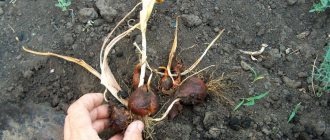Do I need to dig up crocuses after flowering?
There is no consensus on this matter. Bulbs are dug up for forcing, growing in pots in winter or for propagation. In other cases, there is no need to dig them up every year.
If less than 3 years have passed since planting or the last replanting and soil is visible between the plants, the soil is simply mulched with peat or dry leaves. If many daughter bulbs appear (from 1 to 10 can be formed per year), they begin to interfere with each other’s development, and the flowers are crushed. Now the saffron just needs to be planted.
Why replant crocuses?
Gladioli have faded: what to do next
Although saffron is not dug up every year, after 3 or 4 years the need for this procedure becomes necessary. When to transplant crocuses to a new place - the best time for this is in July, when the flower has a dormant period. Over such a long period, the mother bulb manages to acquire many daughter bulbs, they interfere with each other, and the flowers become smaller. To help the flower recover, transplantation is carried out.
Crocus transplant
When can you transplant crocuses from one place to another?
Crocuses are ephemeral plants with a short growing season. They are dug up during the dormant period, which begins around mid-June and lasts until mid-September. Species that bloom in early spring are dug from July to September, and species that bloom in autumn are dug from June to August. Immediately after the buds wither, it is recommended to remove only the peduncles.
The plant itself is left in place until the leaves turn yellow and wither. After this, the mother bulbs are carefully dug up, small young bulbs are separated, washed under running water, carefully examined and diseased and damaged ones are discarded.
Dead roots are removed, old scales are cleaned off. The prepared planting material is dried well in the shade for several days - this will protect the crocuses from mold and reduce the likelihood of infection by fungi.
Video: How to dig and store crocuses
Crocuses have bloomed: your actions
Until now, there is no single opinion among flower lovers on this matter.
Basic wardrobe of a woman over 50 (51 photos)
Some believe that after flowering, the bulbs must be collected , their condition assessed, spoiled ones should be thrown away, and healthy ones should be disinfected (for example, soaked in a pink solution of potassium permanganate and dried, although such a procedure is not necessary).
Others say: there is no need to dig up the bulbs every year ; they overwinter well in the ground. True, in five years their “nest” will grow greatly - that’s when you can pick up a shovel. Moreover, the bulbs can either be completely transferred to a new location, or simply divided: some can be left in the old “nest”, and others can be transplanted.
When should you dig up bulbs?
It all depends on the type of flowers.
- Autumn-flowering varieties are dug from June to August.
- Spring crocuses are removed from the ground from July to September.
In any case, look at the plant: flowering should end and the leaves should turn completely yellow.
Be careful: crocus roots are fragile.
How to store them in winter?
First of all, after removing the bulbs from the ground, they need to be meticulously inspected. Immediately discard rotten and lethargic ones - by placing a single rotten onion in a common box, you will doom all the others.
Planting material needed:
- clean off stuck earth,
- dry it a little
- free from the upper scales,
- trim, removing broken, dry roots,
- disinfect if there is mechanical damage, that is, scratches without rot (ash or crushed charcoal or activated carbon are suitable for this).
Store the bulbs in a basket or box, placing it in a cool place. Make sure that they are not exposed to water (including condensation), as well as sunlight. It is important that the planting material does not freeze. The room (closet) should be about 22 degrees. By the way, before planting, the bulbs can be hardened by moving them to a room with 15 degrees.
A good container option for bulbs: a box made of wood or thick cardboard. If you have several varieties or types of bulbous plants, do not forget to attach a note to each “pile” or cell with the specified variety, as well as the date of collection.
There is no need to cover the box with a lid; the planting material must breathe. Place the bulbs in a loose layer.
Transplanting crocuses
To transplant saffron, choose sunny places with light sandy loam soil. If you plan to plant the bulbs in clay soil, gravel or expanded clay must be added to a depth of about 20 cm, forming a drainage layer. If the soil is dense, coarse sand is scattered over the surface and dug up.
When planting at home, use wide pots, light neutral soil, and form a drainage layer of expanded clay. Before planting, the bulbs are carefully inspected. If there is any doubt about the quality of the planting material, the bulbs are discarded.
When transplanting, try to place the planting material at intervals of at least 7 cm to a depth equal to two diameters of the adult bulb. On light soils they are buried by about 8–10 cm, on heavy soils by 7–9 cm. This allows the mother bulbs to actively grow new scales.
Transplant timing
Crocus is planted for forcing in early October. Autumn-flowering varieties are planted in the ground in the summer in the second half of July, spring-flowering varieties in the second half of September.
Bulb processing
Before planting, gardeners recommend soaking the bulbs in a weak solution of potassium permanganate. Fungicides are also used (for example, Fundazol, Vitaros, Skor, etc.). This procedure will increase the plants’ resistance to gray rot and diseases. Treatment of hyacinths with growth stimulants: Epin, Kornevin, Heteroauxin, etc. also gives good results.
The manufacturer indicates the processing time and dosage in the instructions. Usually it is enough to soak the bulbs in a solution prepared at the rate of 2 ml of the drug per 1 liter of water for 20–30 minutes.
Watering and fertilizing
Newly planted crocuses are lightly watered. Plantings are mulched with a thick layer of pine litter. Subsequently, the amount of moisture affects the height of the flowers. However, they do not like waterlogging and stagnation of water. They are watered in the spring only if the winter has had little snow and the weather is dry.
Preparing the land for planting crocuses in autumn
The main condition for fertile growth and lush flowering is sunlight, so there is no need to plant the bulbs under the shade of trees or shrubs, they need to be allocated the most illuminated area on the site. The body of the bulb is sensitive to moisture, so overwatering is destructive; the plant responds well to fertilizing and grows in light soil.
You can get rid of stagnation of excess fluid by providing drainage. It is made from coarse sand, crushed stone or expanded clay, laying such a substrate at a planting depth of up to 25 cm. Air exchange can be ensured by digging up the ground with river sand and any mineral component, such as manure, humus or compost. In an acidic environment, the bulbous plant will quickly die, so the acid must be neutralized with a mixture of lime and peat. Experienced gardeners know how to plant crocuses in the fall to preserve the tuber and get beautiful blooms.
Diseases and pests
Crocuses are quite disease resistant. And among the pests, the greatest damage is caused by rodents that eat the bulbs. Mice and moles can gnaw them, which leads to rotting and death of the plant. If the flower looks depressed, you should dig it up and carefully examine the bulb. If damage is detected, they are sprinkled with ash or crushed activated carbon and left for 2-3 hours.
If rotten areas are found, they are cut off and the same procedure is carried out. To prevent damage by rodents, the bulbs are planted in special plastic baskets, ultrasonic repellers are installed in the garden, mechanical “turntables”, etc.
The larvae of click beetles (wireworms) also like to feast on crocuses, eating holes in the bulbs. The best way to get rid of them is to make traps. At the end of spring, bunches of unrotted grass, straw or hay are laid out around the area, moistened and covered with boards. The larvae crawl into them. After 2-3 days, the traps are collected and burned along with the pests at the stake.
Disease Prevention
If all the subtleties of agricultural technology have been taken into account, then the plant will practically not get sick. However, if you do not follow them, the crocus can contract viral diseases.
Their signs are:
- deformation and cracking of petals;
- stopping the growth of the seedling;
- yellowing of leaves.
Their occurrence can be prevented by treating with fungicidal solutions. These flowers are often attacked by slugs, night flies, aphids and rodents - the only way out in such a situation is to plant them near cultivated plants.
Sometimes you can notice a flattened crocus with small gray spots on the surface of the petals - this indicates a viral disease transmitted by thrips, mice and aphids. You cannot waste time with diseased plants - you must immediately remove them from the front garden and burn them so that the infection does not have time to spread to other specimens. The place where the infected crocuses were located is watered with a strong solution of hot potassium manganese.
As a preventive measure, you need to carefully inspect the plants you buy.
If wounds form on the bulbs while being removed from the ground, sprinkle them with tree resin and then dry them at room temperature. Save and Share:
When and how long does the crocus bloom?
Crocus (lat. Crocus), also known as flowering saffron, is a genus of herbaceous corms belonging to the Iris family. In the wild, the flower grows in forests, steppes and meadows. Distributed in the Mediterranean, Asia Minor and Central Asia, the Middle East, and also in Europe.
Note! There are crocuses that bloom in the fall, and there are quite a lot of them.
Saffron is a low-growing plant, without a stem, the flowering period occurs in the first half of April. At this time the snow is just starting to melt. Crocuses, when they bloom, are very beautiful, which is why they are so popular in the garden, but the duration of flowering is only a week.
The crocuses in the pot have faded, what should I do next?
Crocuses are often grown for forcing and for the spring holidays - March 8, Easter, we rejoice at these cute plants. However, what to do if the crocuses in a pot at home have faded and lost their decorative appearance. Now the bulb needs rest - it needs to be transplanted into the garden in a sunny, but out of sight place. Spring flowers look ugly in summer.
Then, in the fall, you can dig up the rested bulbs and transplant them to a permanent place in the flower garden, or put them on the bottom shelf of the refrigerator for subsequent forcing.
Planting crocuses in the spring from a pot after flowering is possible at any time, but they will bloom only next spring.
Crocuses after flowering - what to do
What to do with crocuses after their early flowering - cut off the unsightly flower stalks, but the remaining leaves are very decorative. They won't wither long enough. After the plant fades, turns yellow and the entire above-ground part of the saffron dries, the bulbs are taken out of the ground and dried. They need to be planted in early autumn so that the plants can bloom again in the spring.
Once the bulbs are dug up, they need to be stored properly. It is necessary to clean the planting material from soil and dead parts and put it in one layer for storage. The ideal conditions for the bulbs are a temperature of +22°C for successful bud formation, then in August +20°C and a week later +15°C. But at home it is stored in a dark, dry, well-ventilated room.
Additional Information! If you plant hazel grouse, daffodils, tulips and bergenia in a flowerbed together with saffron, it will retain its attractive appearance all spring - the flowers will fade, replacing each other.
However, these flowers do not require annual replanting. If saffron lives in one place for less than 3 years and soil is still visible between the plants, then care consists of mulching with a layer of peat or dry leaves.
Crocus propagation
How to propagate such flowers by children or daughter bulbs, which are separated from the parent bulb during transplantation, is described in detail above. The separated bulbs are planted in open soil in the same way as during initial planting. After the separated daughter bulb is planted in open soil, its first flowering, depending on the variety and type, can be seen after 3 or 4 years.
To propagate spring-flowering crocuses, the seed method is used. But since plants grown from seeds bloom for the first time only after 4–5 years, this method of propagation is not very popular among gardeners. In crocuses that bloom in autumn and grow in mid-latitudes, the seeds do not have time to ripen properly before the onset of winter.
Tips and recommendations from experienced flower growers and summer residents
Experienced summer residents distill saffron at home. The entire cycle that it goes through in its natural environment is repeated for the flower, thus helping the plant to bloom at the right time. In June, the bulbs must be dried and then calcined at a temperature of +34°C for about 7 days. Then the temperature drops to +22-23°C and decreases every 14 days until it reaches +17°C. This falls in mid-August. Then the crocus bulbs are hardened and kept for a month at a temperature of +6°C.
The last stage is rooting the flowers - the saffron is planted in a pot. When planted in September, the crocus will begin to bloom in January. If it is necessary to delay the process, then extend the rooting period.
Like all bulbous plants, crocuses should not be disposed of after they have flowered. They can be literally given a “second life” and get a new harvest from the old one next year.
Crocuses: when to dig up bulbs and plant
When to dig up lilies
When to dig up crocuses depends on the variety of the particular plant. But in any case, this should be done in the summer, when saffron is at rest.
Crocus bulbs
The signal to begin action is the yellowing and dying of leaves. As soon as this happens, the above-ground part should be cut off. When digging, you must try not to damage the roots. Particular care is taken with already overgrown bulbs.
General information about the crocus plant
The name of the plant comes from Latin. Its second name is saffron. Garden crocus belongs to the genus Saffron, the Iris family (Iridaceae), the order Asparagales. The genus includes more than 80 species.
Crocus is a perennial herbaceous plant that blooms in spring or autumn.
The bulb of the plant is covered with scales, it is round or slightly flattened, up to 3 cm in diameter, with a fibrous root system. From it, basal leaves develop and, most often, a single flower (sometimes 2-3 flowers appear).
Based on color, crocuses are divided into yellow-flowered (shades from creamy white to bright orange) and blue-flowered (from pale blue to dark purple). Sometimes there are albinos and flowers with white veins.
In nature, saffron grows in high mountain meadows, forests, steppes of Central and Asia Minor, Southern and Central Europe, North Africa, and the Middle East.
Additional Information! Dried flower stigmas are used as a spice in Asian and Mediterranean cuisine and as a natural yellow dye for homemade cheeses, butter, and liqueurs.
How to process and store bulbs
Plants are inspected. Small sections are treated with charcoal. Healthy planting material is placed to dry in a ventilated, well-lit place, after clearing the crocuses from the soil. Bulbs affected by fungal diseases are burned.
During drying, it is necessary to ensure that insects or rodents do not spoil the bulbs, so they are not left on the ground, but placed in containers on the table. Dry the crocuses for 24 to 48 hours, placing them in rows. For storage, it is convenient to use plastic boxes with holes so that the bulbs are ventilated from all sides.
After drying, when the leaves and short flower stalks turn yellow, they are cut off with scissors. Remove the roots of the flowers. The bulbs are then separated, the scales are separated from the mother plants with a sharp knife, and the sections are covered with a layer of wood ash.
Growing crocuses: features
The plant grows both in open ground, for example, in the garden, and indoors in pots.
- Planted in lighted areas, on verandas, balconies, but not under the scorching sun and without drafts.
- The soil is suitable: neutral, light, loose, well permeable to moisture. The best option is loamy or sandy. For heavy soil, drainage is done to avoid infection of tubers with fungal diseases.
- Crocuses are not picky about soil nutrition. But during the period of growth and flowering, it is necessary to apply phosphorus and potassium fertilizers.
- The plant is drought-resistant. Frequent watering negatively affects flowering.
Flowers in an indoor pot
Important! For abundant flowering, spring crocuses are planted in October, and autumn crocuses in August.
Crocus care
Crocuses are flowers that reproduce on their own. They are unpretentious, but require care. Primroses do not tolerate excessively wet soil, drafts and dense shade. When caring for crocuses, consider the following rules:
- Use only healthy, undamaged tubers.
- To avoid diseases and the proliferation of pests, periodically change the planting location.
- During severe frosts, mulch the flowers using dry leaves, straw, peat or pine needles.
- To avoid damaging tender shoots in the spring, remove the mulch before the growing season begins.
- Before watering the plants, be sure to loosen the soil. This will provide access to moisture and air to the root system.
- Ensure thorough watering after sprouting and during the flowering period.
- Trim off the inflorescences and dry leaves when the crocuses have finished blooming.
If you fertilized the soil before planting the crocuses for the first time, then this fertilizing will be sufficient for a year. Reapply fertilizer containing potassium and phosphorus to the soil already in the second year of life of primroses. Fertilize the soil in three stages. Apply fertilizer first when the first shoots appear, then repeat the procedure when buds are setting. Feed the crocuses one last time after flowering. Prepare the first fertilizing in the following proportion: 2 parts potassium and 1 part phosphorus. In the future, mix fertilizers in equal parts. If you plan to transplant the flowers to another place, carefully dig up the tubers and dry them in a ventilated place. After that, put them in a box, wrap each onion in newspaper, and put it in a cool, dark place. Save the planting material until September–October, after which you plant the flowers in open ground. As soon as the snow begins to melt, crocuses will again delight you with lush blooms. It lasts only 7–10 days, but with its beauty and tenderness, crocuses can create a mood and evoke positive emotions.
Which crocuses do not need to be dug up in the fall: varieties
This season marks the flowering phase of autumn crocuses. Varieties of this variety are almost unknown to amateur gardeners. Here are some of them:
- Crocus Sharoyan has lemon-yellow rounded petals. Blooms in the second half of September.
- Sowing - large purple flower stalks. Its fragrant stigmas are dried and used as a spice. Blooms in September-October.
- Beautiful - one of the early tall varieties. It blooms in early September with large white or lilac flowers.
- Long-flowered - has different colors, late variety, flowering phase in November.
- Pretty - light purple large flowers, forming inflorescences of 5-10 pieces on one bush. They bloom in October.
- Kholmovoy - miniature white, appears in September.
- Banatsky - lilac flowers resemble the shape of an iris. It pleases the eye with its blooms throughout September.
Varieties of crocuses for planting in autumn
Crocus is also called “spring saffron”; it is used to decorate flower beds in summer cottages in early spring. Often used to create green slides. The bulbous plant does not require care. In the fall, crocuses are planted in open ground, and care ends there until spring - the grower just needs to wait for shoots and the appearance of flower stalks.
Not all varieties can achieve flowering in early spring. The following varieties are early flowering:
- Spring crocus. Like other varieties, it is a herbaceous plant with a stem length of about 15 cm. The flower is funnel-shaped, purple or white, and the anther is yellow. An adult bulb is renewed annually and reproduces no more than 3 flower stalks during the growing season. This type includes the following varieties: Nigro Boy, Pickwick, Remeberance, Stoustor.
- Golden-flowered. The plant is about 20 cm long, the yellow flower appears before the narrow, bright green leaves. The bulb is crushed, spherical in shape. The species includes the following varieties: Blue Pearl, Lady Killer, Snowbunting, Blue Bonet.
- Crocus Heifel. Plants are distinguished by the following varietal characteristics: round bulb, linear leaves with curled edges, purple or white petals. These varieties are valued for their long (more than 25 days) flowering. The group includes: Oxonion, Bagila, Albus, Artabir.
- Tomasini. Varietal characteristics: low plant up to 8 cm in height, narrow leaves, large flower of purple, white or lilac color. It is an industrial variety and has no value for collectors. Often used for landscaping city parks and flower beds. Varieties: Lilac beauty, Rossi, Purple giant.
Interesting to know! Crocus or reticulated saffron is an incredibly beautiful variety, distinguished by longitudinal stripes on its flower petals, but it is impossible to grow it in a personal plot.
The rare species is listed in the Red Book. Under natural conditions it is found in Russia, namely in Crimea and Transcaucasia. These crocuses can be planted in the fall, unlike late-flowering varieties. Despite the fact that the plant is not particularly demanding, for good flowering it is necessary to provide it with good conditions and proper planting.
How to properly prepare crocuses for storage
Dry the onions in a cool, shady place for 24 hours.
Then they carefully inspect for mechanical damage from pitchforks, insects, rodents, as well as for the presence of mold, disease, and ulcers.
The surface must be dry, without peeling scales, stains, and uniform in color.
Poor quality, spoiled ones are rejected and destroyed. Healthy, dense, large, clean onions are treated with phytosporin or a light dose of potassium permanganate and stacked according to variety for storage.
Digging and storing autumn crocus bulbs for planting
Autumn crocus must be dug out of the ground before frost sets in, after the entire vegetative cycle is completed. Often the above-ground green part does not have time to retire by this time, so it is removed with scissors. All bulbs must be inspected for rot, pests and mechanical damage.
It is better to store the collected planting material in special boxes made of chipboard or wood. The bulbs are laid in one layer and sprinkled with sawdust; after such insulation, the next layer can be laid. You can store plants in the basement or cellar.
How to store at home
The air in the room where the planting material is located should be fresh and cool. The temperature should be +15..+18 °C during the entire storage period.
Storing bulbs in boxes
For spring crocuses, the period of rest and storage is July-September, and for autumn crocuses - June-July.
Indoor crocuses and those for forcing are stored until early spring. At the same time, a lower temperature regime is observed - +10..+13 ° C. They are planted 2.5 months before the desired flowering period.
Important storage rules before replanting crocuses:
- air temperature is not higher than + 18 °C and not lower than 0 °C;
- dry, well-ventilated area;
- cannot be placed in plastic bags, poured in bulk or folded in several layers in one container.
Attention! In cold weather, the onions are stored on an insulated balcony at an air temperature no higher than + 18 °C and no lower than 0 °C.
Cardboard and plastic wooden boxes with holes for ventilation, wide low containers with a layer of sandy soil and drainage and holes in the bottom, a nylon stocking or mesh bag, and paper trays for eggs are suitable.
Crocuses for forcing are placed on the shelves of a dry basement or cellar, where the temperature does not rise above + 10..+15 °C. Use the same container as for storage on the balcony. If the basement is visited by rodents, then the planting material is placed in one layer in small glass or metal jars and covered with a lid with narrow holes.
In the summer months, if there is no basement, each onion is wrapped in newspaper or thick paper and placed on the lower shelves or in refrigerator drawers. Containers and pots with crocuses are also placed there until the time for planting comes.
Planting crocuses in the ground in autumn
Planting in the ground begins with choosing a suitable location. Ideally, it should be well lit and moderately humid. There is no need to plant flowers in the ground after tomatoes or potatoes - these crops pull all the nutrients from the soil.
Attention!
Long-term stagnation of melt water is not allowed, therefore, when planting, you need to take care of the need for proper drainage.
Crocus planting dates
The timing of planting any plant is a relative concept that varies depending on the region. Small bulbs take approximately 2-3 weeks to take root. Exposure to the sun and heat during this period is not required; it is important not to allow the earthen clod to dry out.
Early planting in the ground in the fall is dangerous for the bulb, because it can germinate. If a sprout with greenery comes to the surface, after the onset of frost the plant is highly likely to die.
You may be interested in:
Crocuses: planting and care in open ground, photo As soon as the snow melts, the first flowers immediately appear - snowdrops, but after them they begin to bloom very...Read more...
Soil for crocuses
The soil is dug up to a depth of 20 cm, and excess weed roots and debris are removed. For a plot of 1 sq.m you need to add:
- 5 kg of sand;
- compost or humus 5 kg;
- ash 300 g;
- potassium salts 30 g;
- superphosphate 50 g.
If the soil is clayey, add additional perlite.
Preparation of planting material
A healthy bulb meets the following qualities:
- dense;
- heavy;
- has dry scales;
- size – 3-8 cm in diameter.
Of course, traces of rotting, mechanical damage or the presence of products of pest activity indicate the unsuitability of the material for planting.
Before planting, high-quality material is treated with a solution of potassium manganese or Fundazol. To do this, just soak the onions in the prepared solution for several hours.
Not suitable for planting in winter:
- bulbs up to 3 cm in size are babies that will not survive the frost;
- plant with awakened sprout.
Children and bulbs with sprouted greens are planted in bowls in the fall and placed in a basement or cellar until spring. You can plant them in open ground in the spring, but the children will not bloom.
At what depth to plant crocuses?
Small bulbous plants are recommended to be planted in groups. The bulbs are arranged in longitudinal clearings, maintaining a gap of 4-5 cm between the rows. For the convenience of collecting planting material, gardeners bury them together with a special bowl. You need to make large drainage holes in it. The bulb is planted to a depth of 8-12 cm, depending on the type of soil.
Secret!
In order for crocuses to bloom for a long time, the bulbs are planted at different depths; a difference of 2-3 mm ensures that a plant planted deeper will give color 2-5 days later.
Planting scheme
They should be placed in a group to ensure lush flowering after the buds open. One tuber requires about a square area of 15*15 cm. It is recommended to deepen the root by 5-12 cm, depending on the size of the tuber and the quality of the soil. If the soil is loose, it is optimal to deepen it by 8-12 cm; plant it in hard soil to a depth of 7 cm.
Soil insulation
Special insulating structures for wintering crocuses after planting in the fall are not required. The plant normally tolerates light frosts; the bulb survives even when the ground surface is icy. There is a risk of losing the plant in the following cases:
- the bulb is a baby, has a small diameter;
- the plant is affected by rot;
- planting material is placed in excessively wet soil;
- a small bulb is embedded in the soil to a minimum depth.
The consequences of death can be avoided by mulching. It is recommended to sprinkle any available organic material on the soil. If small bulbs are planted in the ground, you can additionally cover them with dry branches or burlap. Waste in the form of plant tops is not used as mulching material. They are often a source of bacteria and fungus.
When to plant crocuses - can they be planted in spring and at what depth?
Crocuses are small bulbs. It is these bulbs that are planted in open ground. The autumn option is best suited. By planting a crocus in the fall, you can watch it bloom in the spring.
The autumn flower is very unpretentious, even if planted in partial shade. But here's the thing about the spring look. It should best be planted in well-lit areas.
There should be maximum sun, but minimal shadow. The autumn species is planted from late July to mid-August. If the plant is planted too late, then for the first couple of years it will not bloom. There will be only leaves. But the buds themselves will appear only after 2 years.
The only problem with the flower is waterlogging. Often, due to constant humidity, the root system begins to rot. Therefore, this should not be allowed.
Flowering ends in autumn. The leaves dry out and fall off. At this point, you can transplant the crocus to another place. You can do this right away or dig up the bulbs.
Leaving their planting until next year. Be sure to sort through the bulbs and throw away the unusable ones. They should be stored at temperatures up to 22 degrees. If the flower grows well in this place, then you don’t need to replant it. It will be enough to remove the limp and dry leaves on the stems.
Is it possible to plant in spring?
Crocuses can be planted in both spring and autumn. It depends on the plant variety. It is necessary to take into account that if the variety is autumn, then it should be planted only in the fall.
If the plant is spring, then planting is carried out in the spring. If the variety is planted incorrectly, it may simply not take root or even sprout.
Planting stages:
- Dig a small hole. For a large onion, the hole is up to 12 cm deep. For small ones, up to 6 cm.
- There must be drainage or sand in the ground. Then the ground will be looser and the air will be passable.
- The bulbs are planted at least 3 cm apart from each other. This is enough if the gardener does not intend to replant the plant.
- Lightly press the bulbs down and cover them with soil.
- Water. Don't overdo it.
- Wait until completely absorbed. Cover with soil. You can sprinkle river sand on top.
- The best fertilizers are potassium and phosphorus.
- In hot weather, water frequently. But only if the soil is dry. If moisture is present, then don't.
- By winter, crocuses are half covered with soil or covered with film. This is done so that the flower survives the winter and delights in the spring with its beautiful blooms.
Popular spring species:
- Reticulate.
- Golden.
- Adam.
- Narrow-leaved.
- Two-flowered.
Popular autumn species:
- Sowing.
- Palace.
- Sharoyan.
- Banatsky.
- Pretty.
How to land correctly
You don't have to be a great gardener and know everything about plants. The flower is unpretentious in care.
To plant a crocus correctly, you need to know a few rules:
- If the soil is clayey, then you definitely need to add sand. You can also add fertilizers such as manure and compost.
- Crocuses love soft, loose soil.
- The soil should not be allowed to become waterlogged. The plant doesn't like this.
- The landing site should be well lit by the sun. Then the flower will be large. If they grow in the shade, then they will be small.
- Feed and fertilize periodically.
- Fertilizers must contain phosphorus and potassium.
Small tubers are planted at a depth of up to 6 cm. But large tubers are planted up to 12 cm deep. There is no need to plant very deeply. This is of no use. As the root system grows, it goes deep enough.
When planting in the fall, it is recommended to dig up the soil. Add sea sand and humus to it. This is done at least two weeks before planting the plant.
The soil should be light. Then the flower will feel comfortable.
Benefits of Crocus:
- Unpretentious in care.
- Early flowering. Unlike other colors.
- Bright flowers stand out from others.
- The flowers have a light, delicate scent.
- Even a non-professional can plant them.
- The bulbs can be stored for planting next year.
- Crocuses reproduce on their own. With the help of seeds that they throw into the ground. Next, they form an onion. Which continues to grow.
- Great for design.
- They can be grown both in the garden and in a pot at home.
Feeding principles:
- Organics in complementary foods are unacceptable.
- Rotted manure, peat and other natural fertilizers.
- Feed only in spring.
- The fertilizer is scattered over the surface around the flowers.
- Feeding after flowering. Potassium sulfate, phosphorus, and potassium sulfate work well.
All about crocuses. How to grow and care
When, after prolonged frosts, the first flowers begin to appear from under the melting snow cover, we are all incredibly happy about them. Crocuses are usually the first to appear. These are spring, bulbous flowers that begin to bloom in early March, immediately after the snowdrops bloom. The bloom time for these magnificent flowers is approximately a week. After some time, after the buds fade, the leaves begin to dry out and turn yellow. It is during this period that the crocuses begin their dormant time. In addition, there are crocuses that completely finish their flowering period at the end of October, in November. Plant these uniquely beautiful flowers in your garden. Their planting and further care will not require any special work or skills from you. And with the onset of spring, you will begin to admire the beautiful, first flowers.
Do I need to dig up crocuses after the flowering phase?
Many gardeners at this time are beginning to dig up corms in their summer cottage. And others, on the contrary, leave them in the ground. It is worth noting that crocuses are perennial flowers that can grow even at home and in one place for several years. It is also necessary to dig up the root system of these flowers for preventive purposes, to be able to remove diseased and damaged planting material. After this procedure, the selected crocus corms must be planted in a new place in open soil. Of course, if your crocuses grow in the lawn itself, then you should not dig them up. In this article we will talk about when to dig up crocuses after flowering and learn other details of their cultivation.
The best conditions for crocuses
Many people like crocus flowers. However, in order to achieve beautiful flowers, proper planting and care in the open ground must be carried out. When planting crocuses at home, you must adhere to the following care rules: These flowers prefer loose and light soil. Excess moisture in the soil can lead to poor health of these plants. Based on this, if you plant crocuses at home in loamy soil, then you must add a small amount of sand and fertilizer to it. These soil nutrients can be manure or peat.
Since crocuses are light-loving plants, they should be planted in well-lit places at home. The size of the flower stalks and the abundance of their flowering will depend on this. The more light these flowers can receive, the larger their buds will be. Planting crocuses at home or on a personal plot in a slightly darkened place is possible, but in this case the flowers will be small.
Crocuses can be planted in flower beds, flower beds, combining them with other plants, for example, daffodils, tulips, hazel grouse, etc. This will ensure your lawn continues to bloom throughout the spring.
The soil in which crocuses bloom should always be moist. Young shoots that have been salted from corms need to be watered regularly. The top layer of soil must dry out before each watering of flowers.
Crocuses prefer fertile soil. For this reason, these flowers, planted at home in nutritious soil, are not fertilized at the time of flowering. If flowers grow in one place at home for many years in a row, they must be fed. Nutrients must be added to the soil itself. As a rule, potassium-phosphorus fertilizers are used for crocuses. Phosphorus is able to ensure the massive formation of plant flower stalks and prolong their flowering period. Potassium is able to maintain plant bulbs in a healthy state. Fertilizers must be applied three times throughout the season. The very first feeding of crocuses is done at the moment of formation of its sprouts. The second should be carried out at the moment of bud formation. Third, it needs to be done after the crocuses have completely faded. When applying fertilizer for the very first time, the amount of potassium must be 2 times more than phosphorus. During the 2nd and 3rd feedings, these two substances must be taken in equal proportions.
How to plant autumn and spring crocuses
Currently, breeders have been able to develop a large number of varieties of crocuses. Among them there are both spring and autumn varieties. The last plants are planted in early June. Spring crocuses are planted in the ground at the end of September. Larger corms are planted at home to a depth of -10-12cm. medium-sized bulbs are deepened into the soil by about 6-7 cm. The distance between planted plants must be at least five centimeters. If replanting crocuses on a summer cottage is not planned in the next 2-4 years, then they should be planted close to each other (at a distance of 3 cm).
You need to start caring for corms at home in mid-summer. And it is by this time that the crocuses will be able to fully bloom. If you do not plan to transplant flowers, then their corms should be left in the same place. In such a situation, you need to prune faded flowers and leaves. In the southern regions of our country, with its warm and mild climate, crocus corms can easily endure the winter. As for harsh climatic zones, flower beds with plants must be covered with small twigs or fallen leaves. If you plan to transplant crocuses to a new place, then the corms must be dug up in mid-summer (late June, early July). In this case, the planting material should be thoroughly sorted and only large and healthy bulbs should be selected for planting. To be able to preserve planting material, it must be placed in a ventilated room in which a constant temperature of 21-22 degrees will be maintained.
Forcing crocuses
There is a practice of growing crocuses at home. Flowers can grow well both on the windowsill and indoors. Therefore, it is worth learning about what forcing crocuses is. In this case, caring for indoor plants will be slightly different. Plant bulbs must be planted at the end of the autumn period. They should be stored in a cool place. One month before you want to have flowers, a flowerpot with corms must be placed on the windowsill and watered for several days in a row.
Crocus propagation
If you are interested in how crocuses should be propagated, now we will tell you more about this process. Autumn crocuses are propagated in the same way as spring crocuses. In room conditions, this procedure will be simple. As a rule, after the crocus flowering period ends, the corm completely dies. And in its place, small baby bulbs begin to form. They should be separated and planted separately. One year after planting, young crocuses should bloom for the first time. After they become very crowded, the flowering of crocuses will not be abundant, and the flower stalks will be small. To avoid this, the plant should be replanted. As a rule, replanting flowers in a summer cottage should be done every four years. You can also get new plants from seeds at home. But as a rule, they lose their personal varietal characteristics. But as for the hybridization process, it is quite difficult to carry out, since it is necessary to have some experience. The best option is to purchase crocus bulbs in a special store. Spring or autumn crocuses are plants that are often used to decorate flower beds, alpine slides, ponds or borders. These flowers can be perfectly combined with primroses, scillas and other types of corms.
When should crocuses be planted - autumn or spring?
Crocuses are one of the very first spring flowers. They begin to bloom earlier than others in the country. In order for the first crocus buds to appear at the right time, you need to know exactly when to plant them in spring or autumn. This question is especially important for new gardeners, since crocus bulbs can be purchased at any time of the year.
Spring and autumn crocuses
This is how these beautiful and delicate flowers belonging to the iris family should be classified. Resistant and quite unpretentious to the harsh Russian winter, crocuses can actively grow throughout the year and bloom in early spring and autumn. Few people know that there are autumn species of these plants. Due to this, some confusion arises regarding when crocuses should be planted. It is best to carry out this procedure in the autumn.
The period of growth and development of the corm in spring crocus species, as a rule, begins with the onset of early autumn. Next, the leaf mass begins to grow, the buds bloom, and then the plant enters its dormant phase, thus accumulating strength in the bulb. Then children begin to form in it. It is these types of crocuses that can be found in specialized flower shops and in crowded markets.
It is very difficult to find autumn crocus species. As a rule, their life activity begins in the autumn. Next, the leaves begin to grow. And the flower often begins to disappear under the snow cover with its buds already open. The planting period for these plant species is late July - early August. If you are a little late with this, then the plant simply will not have time to fully form and will not please you with ripe children.
Planting spring crocuses
If you want to know whether crocuses are planted in the spring, then know that this can be done not only in spring, but also in autumn. For those people who do not know how to plant crocuses in the autumn, you should first determine the type of your plant. Spring crocuses should be planted at the very beginning of September, at a time when the plant bulb is in its dormant phase. Having accumulated enough strength for the winter period, the flower begins to bloom its first buds in early April.
You should prepare the soil in advance: dig up 10-15 days before planting, add humus to the soil. But there is no need to be zealous with the application of complex mineral fertilizers. With the onset of next year, after the crocuses have completely faded, you must wait until the leaves of this plant dry completely. Only after this will it be possible to dig up the flower bulbs and store them until September. Tulips are also cared for. Weather conditions can determine the period when crocuses and tulips should be planted. Cool and dry weather is more favorable for this procedure. But you need to be in time before the first frost.
Planting autumn species
Autumn crocus species should be planted in late summer. Planting a plant too late can cause its corm to form incorrectly, producing only leaves but not flower stalks. Based on this, the next question immediately arises - when is it necessary to plant crocuses. In the autumn period (autumn) is the period of planting spring-flowering plant species. In the summer (end of July), it is necessary to plant autumn-flowering species. Not all flower growers plant crocuses annually, leaving them in the same place for 3-5 years. It should be noted that with this approach to business, the crocus flowers become smaller, the foliage begins to grow, and the plants become very crowded. Based on this, to ensure the best flowering of crocuses and obtain good planting material, it is necessary to dig them up and divide them every year. If the location you choose has sandy loam and light soil, there is no stagnant water, and the area is well lit, the flowers will bloom much faster.
Crocuses planting and care, reproduction, flowering, replanting, wintering, diseases, photos and videos
Saffron or crocus are among the most beautiful primroses in appearance. A group of these flowers will become a real decoration for your dacha. As a rule, most crocuses begin to bloom in the spring. But there are some types of these plants that bloom with the onset of autumn. This must be taken into account when choosing corms.
Homeland and appearance of crocuses.
In this article we will talk in detail about when to dig up crocuses and how to store them until planting in the fall. However, first of all, it is worth providing other very useful information about these plants. A large number of crocuses grow in the Crimea, in Central Europe, and also in the Caucasus, Central Asia, Turkey, Iran and the Black Sea region. Many crocuses are listed in the Red Book. Saffron is a short flower - up to 14-15 cm. It has no stem, with a corm. The color of its flowers is very diverse: yellow, white, two-color, purple. The flowering time of crocuses is from 2 to 3 weeks. The leaves of the plant are flat and narrow. They begin to appear along with the inflorescences, or a little later. Basically, crocuses are quite unpretentious flowers. It is better to purchase planting material at the end of August or beginning of September. Autumn types of crocuses are usually planted in the last ten days of August. And spring ones are in September. To plant flowers, you must choose corms without sprouts and sprouted roots.
Watering mode.
Crocuses should be provided with good watering immediately after the first shoots appear. They should be watered throughout their growth. Before watering, you need to loosen the soil a little so that moisture and air can penetrate to the root system of the plant.
Lighting mode.
Crocuses need bright light so that large inflorescences can form. If flowers are grown in partial shade, then their buds will be small.
Fertilizer and top dressing.
If the soil is well fed before planting the plants, then during the period of active flower growth in the first year they do not need to be fertilized. But still, it should be noted that in the future the crocuses will need additional nutrition. It is imperative to fertilize the soil with a high content of potassium and phosphorus. The very first feeding is done after the first shoots appear. The second feeding of the plant should be done at the time of cutting the buds. The third - after the complete end of the flowering phase. At the time of the first feeding of crocuses, the potassium content must be 2 times higher than phosphorus. Next, you should mix potassium and phosphorus in equal proportions.
Choosing a place for landing and transfer
Find out from this article whether you need to dig up crocuses after flowering? In addition, check out other information. A very important point when planting crocuses is to choose a well-lit and drained area. For these plants, you must definitely try to organize a constant outflow of moisture. Otherwise, the flower corms will become sick and simply die. The best choice is light and sandy loam soil. An area with too dense soil can be diluted with sand, which should be scattered over its surface. Next, the area for planting crocuses needs to be dug up. In addition, the soil should be fertilized before flowers are planted. Compost or mineral fertilizers with a high content of potassium and phosphorus act as fertilizing. It is not recommended to feed crocuses with fertilizers containing a lot of nitrogen, since this substance is harmful to these plants. If there is insufficient lighting, crocuses may stop flowering and completely wither. For this reason, you should choose a well-lit area. But it must be protected from strong gusts of wind and drafts. As a result, the delicate flowers of the plant begin to bend and lose their petals.
Crocus planting technology
In order for crocuses to be beautiful, proper planting and good care are important, which you will carry out at home. Considering the fact that crocus corms grow small, they are planted close to each other. In addition, a group of flowers planted close to each other will look very beautiful and attractive. But still, you should definitely provide free space for future children who will appear on the corm in the future. A suitable distance between these flowers is from 3 to 5 cm. As for the planting depth, it will usually depend on the size of the corms themselves. Very small ones should be planted to a depth of five centimeters, and larger ones to a depth of 10-12 cm. It should also be taken into account that after the flowering phase of crocuses ends, the strong root system of these flowers begins to pull the corm deep into the soil. If you want to obtain material for forcing crocuses, then the corms must be planted as deep as possible. And for faster reproduction, you should choose a shallower planting.
Planting crocuses in pots
It will take at least 3-4 months to force crocuses. In order for crocuses to bloom before the New Year, they should be planted in early September. To be able to give these beautiful plants as a gift for Valentine's Day, they need to be planted in early October. To get beautiful flowers by March 8, crocuses need to be planted in mid-November.
Before planting crocus corms, it is necessary to keep them in the following conditions:
- 1-1.5 weeks at summer temperatures.
- 2.5-3 weeks at a temperature not higher than 19-20 degrees.
- When the temperature is not +10 degrees in August.
Before planting, the corms must be kept in the refrigerator at a temperature of no more than 8-9 degrees.
Then you need to plant the crocuses in a container with a layer of good drainage. Ordinary sand can be used as a substrate.
Crocus propagation
In this publication you can find everything about crocuses. Here are their varieties, as well as information on how planting should be done. And here you can learn about how to care and reproduce. There are three main ways to propagate crocuses:
- Children.
- Seeds.
- Corms.
In each method described above, the plant is planted in early September. This is done so that by the beginning of winter the crocus can get stronger and take root well. In this case, it is necessary to dig up the plant’s corms in June, after the end of the flowering phase. Then the planting material must be thoroughly dried, ventilated and stored in a cool place until planting.
Some gardeners dig up and plant crocuses only once every 5-6 years. But still, many experts advise carrying out this procedure much more often in order to avoid crushing the peduncles. The most optimal frequency of planting crocuses should be once every 3 years. You can also propagate crocuses in an accelerated way. To do this, you need to dig up the plants every year after they finish flowering. Each flowering crocus bulb can produce up to 4 bulbs and up to 9-10 children.
Blooming crocuses
All types of crocuses are divided into 2 main types:
- Spring flowering period.
- Autumn flowering period.
The flowering period of these flowers will depend on the following main factors: plant variety and weather conditions. The peduncle of the crocus resembles the shape of a glass. Crocus flowers come in different shades: Yellow, white, purple, blue, cream, orange. There are also varieties that have two-colored inflorescences, spotted and even checkered. The diameter of the flowers can vary from 2 to 5 cm. Crocuses look more original and beautiful in the garden in 8 - 10 pieces. As a rule, they are used as independent plants. They can also be combined in a group with other plants that bloom in spring. Crocuses look more attractive among rich green grass.
Wintering crocuses
Now you know when to dig up crocus bulbs after flowering. Remember that proper wintering of crocus corms is an important component of caring for these plants. During the wintering period, crocus bulbs begin to take root and gain strength, which will be required for the further development and flowering of this flower. After severe frosts set in, crocuses can be covered. But still, in the warm regions of our country, crocuses winter well without any insulation. In addition to protection from severe frosts, spruce branches and spruce branches are used as a barrier against many rodents, which in turn prefer to feast on crocus corms. In the spring, this insulation must be removed from the plant and all debris removed. It will be possible to loosen the soil for the first time near the crocuses only after the first shoots appear. Otherwise, you can easily damage the roots of the plant.
What to do after crocuses bloom
After the end of the flowering phase, around mid-June, you will need to trim the dry leaves and inflorescences of the plant, and dig in the corms. It is recommended to store the dug up planting material at a uniform temperature decrease. Within one week after digging the bulbs, they are dried and ventilated. Further, they can be placed in a basement or cellar, where it is quite dark and cool. After 2-3 weeks, all planting material should be transferred to vegetable boxes in the refrigerator. Corms should be stored until planting. Crocuses should be planted in the second decade of September or in the first half of October.
Why don't crocuses bloom?
The absence of peduncles in crocuses indicates improper care.
The main reasons: 1. The corms of the plant were dug up before the onset of the dormant phase. Based on this, the flowering period of the crocus is completely disrupted. This usually leads to a lack of flowers on the plant. 2. In addition, it is not recommended to trim the leaves of the plant ahead of time, since next year the flower may not have buds at all. This procedure can be carried out after they have completely withered. 3. In order to stimulate long and abundant flowering of the crocus, after digging the corms should be stored at low temperatures. 4. Crocuses may stop growing completely if they grow in the same place for a long time and do not rejuvenate. In order to rejuvenate crocuses, you need to dig up the corms every 4-5 years. Then seat them. But still, many gardeners advise carrying out this procedure every year. 5. In addition to all of the above, very often when corms are stored in winter, they are damaged by rodents. As a result, with the onset of spring, buds do not appear on the crocuses.
Why don't crocuses bloom in spring?
Most gardeners, when purchasing crocus corms, do not pay any attention to their flowering phase. Many people believe that all crocuses, without exception, begin to bloom in the spring. But still, this is far from the case. There are varieties of crocuses that bloom with the onset of autumn. The two types of crocuses differ in their development cycles. It follows that they require different personal care.
Diseases and pests of crocuses
Very often, crocuses are harmed by aphids during their active growth. In addition, aphids can also be seen in places where corms are stored. Not only can aphids cause serious damage to flowers, but they can also carry all sorts of viral diseases. To combat these insects, a low concentration of karbofos solution is used. If a plant does not have enough nitrogen-containing fertilizers, then they begin to develop various diseases that are caused by a fungus. In this case, before planting, the corms should be treated with copper-based products. Diseases that are viral in nature negatively affect the shape of the plant’s flowers and their color. Basically, it is not possible to completely cure a plant in case of a viral disease. In this situation, it is imperative to monitor the plants and remove damaged flowers in a timely manner.
Video on caring for crocuses
The very first flowers to bloom at the dacha after a long winter are crocuses. These are very bright, delicate flowers. Despite its small size, crocus is grown with great pleasure by a large number of gardeners, since this particular flower is easy to care for and not demanding of itself. In addition, crocus can be easily propagated. To do this, it does not need to be dug up during the winter. As a rule, this flower is planted in groups so that with the onset of spring one can admire the beautiful and abundant flowering.











